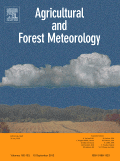
AGRICULTURAL AND FOREST METEOROLOGY
Scope & Guideline
Advancing knowledge at the crossroads of climate and agriculture.
Introduction
Aims and Scopes
- Climate Impact on Agriculture:
Research on how various climate factors, such as temperature, precipitation, and extreme weather events, affect agricultural practices, crop yields, and food security. - Forest Ecosystem Dynamics:
Studies exploring the impacts of climate change on forest ecosystems, including tree growth, carbon dynamics, and biodiversity. - Hydrometeorology and Soil Moisture:
Investigations into the relationships between soil moisture, precipitation patterns, and their effects on vegetation and ecosystem services. - Remote Sensing and Modeling Techniques:
Utilization of advanced remote sensing technologies and modeling approaches to assess and predict ecosystem responses to climatic changes. - Carbon and Water Fluxes:
Research focusing on the measurement and modeling of carbon dioxide and water vapor exchanges in various ecosystems, contributing to our understanding of global carbon cycles. - Phenology and Plant Responses:
Studies regarding plant phenology, including the timing of flowering and leaf senescence, in relation to climatic variables and environmental stressors.
Trending and Emerging
- Machine Learning Applications:
The integration of machine learning techniques for predicting crop yields, assessing ecosystem functions, and analyzing large datasets is rapidly gaining traction, showcasing the potential for advanced analytics in agricultural meteorology. - Climate Resilience Strategies:
Research focusing on adaptive strategies that enhance resilience in agricultural and forestry systems to cope with climate variability and extremes is increasingly prevalent. - Carbon Sequestration and Climate Mitigation:
Studies exploring carbon storage potential and the role of forests in climate mitigation are on the rise, emphasizing the importance of managing forests for carbon capture. - Impact of Extreme Weather Events:
There is a growing focus on understanding how extreme weather events, such as droughts and floods, impact ecosystems and agricultural productivity, leading to research on risk assessment and management. - Ecosystem Services Valuation:
Emerging interest in quantifying and valuing the ecosystem services provided by forests and agricultural landscapes is evident, linking ecological health to economic benefits. - Soil Health and Management:
Research on soil health, including the effects of management practices on soil carbon dynamics and nutrient cycling, is increasingly recognized as vital for sustainable agriculture.
Declining or Waning
- Traditional Agricultural Practices:
Research on conventional farming methods has seen a decline as newer, more sustainable practices and technologies gain attention, particularly in the context of climate adaptation. - Historical Climate Analysis:
While historical climate studies provided foundational knowledge, there is less emphasis on retrospective analyses as the field shifts towards predictive modeling and real-time data applications. - Static Models of Ecosystem Processes:
Static or less adaptive models are being phased out in favor of dynamic, integrative approaches that account for changing environmental conditions and interactions. - Local vs. Global Scale Studies:
There is a decreasing emphasis on purely local studies as the journal increasingly publishes research with broader, global implications, reflecting a shift towards collaborative, cross-regional research efforts.
Similar Journals

Turkish Journal of Agriculture and Forestry
Driving impactful research in agriculture and forestry.Turkish Journal of Agriculture and Forestry, published by the Tubitak Scientific & Technological Research Council Turkey, stands as a significant platform for disseminating impactful research in the fields of agriculture, forestry, and ecological sciences. With an ISSN of 1300-011X and an E-ISSN of 1303-6173, this esteemed journal has maintained its commitment to advancing scientific knowledge since its inception in 1994 and continues to provide peer-reviewed content through 2024. The journal has earned a commendable Q2 ranking in multiple categories, including Ecology, Food Science, and Forestry, as well as impressive Scopus rankings within its respective categories, placing it in the top quartiles of its fields. This positions the Turkish Journal of Agriculture and Forestry as a critical resource for researchers, professionals, and students seeking to explore innovative solutions and significant advancements in agricultural practices and ecosystem management.

Journal of Forest Research
Elevating the dialogue on environmental sustainability.Welcome to the Journal of Forest Research, a pioneering publication dedicated to advancing the field of forestry and sustainable ecosystem management. Published by Taylor & Francis Ltd and boasting an impressive Q2 ranking within its category, this journal highlights significant research contributions and innovative practices in forest science. With an ISSN of 1341-6979 and E-ISSN of 1610-7403, the journal spans a fruitful history from 1996 and continues to be an influential platform up to 2024. The Scopus rank places it at an esteemed #55 out of 174 in the realm of Agricultural and Biological Sciences, reflecting its high impact within the community. While this journal is not open access, it offers targeted content for researchers, professionals, and students seeking to deepen their understanding of forest ecosystems and promote sustainable practices. Join us in exploring the intricate relationship between society and forests, and contribute to a crucial dialogue on environmental stewardship.

Range Management and Agroforestry
Fostering Collaboration for Sustainable Land ManagementRange Management and Agroforestry, published by the RANGE MANAGEMENT SOC INDIA, is a pivotal journal dedicated to the advancing fields of range management, agroforestry, and sustainable agricultural practices. With an ISSN of 0971-2070, this journal has carved out a niche for itself within key Agricultural Sciences categories, achieving a commendable Q2 ranking in Forestry and Q3 in both Agronomy & Crop Science and Food Science as of 2023. It serves as a vital platform for researchers, professionals, and students to disseminate and access innovative research findings that address the pressing challenges in land management, biodiversity conservation, and food security. Spanning a convergence of years from 2009 to 2024, the journal provides insights into practical applications and theoretical advancements in managing grasslands and agroforestry systems, further emphasizing the role of interdisciplinary approaches in tackling ecological and agricultural issues. With a focus on enhancing knowledge within India and beyond, Range Management and Agroforestry is instrumental in fostering collaboration and communication among scholars striving for sustainable solutions in a rapidly changing environment.
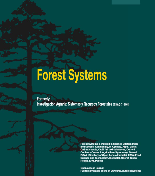
Forest Systems
Exploring the intricate dynamics of forest ecosystems.Forest Systems, an esteemed open-access journal published by CONSEJO SUPERIOR INVESTIGACIONES CIENTIFICAS-CSIC in Spain, has been a dedicated platform for advancing knowledge in the fields of ecology, forestry, and soil science since its inception in 1991. With an ISSN of 2171-5068 and E-ISSN 2171-9845, the journal is committed to disseminating high-quality research that addresses critical issues related to forest ecosystems and their management. Forest Systems is positioned within the Q4 category in Ecology, Evolution, Behavior and Systematics, and Q3 in both Forestry and Soil Science, evidencing its growing influence and relevance in these disciplines. Researchers will find a rich repository of articles that not only contribute significantly to academic discourse but also foster practical solutions to contemporary environmental challenges. As it converges from 2010 to 2024, the journal aims to enhance its outreach and impact, facilitating access for professionals, students, and policymakers committed to sustainable forest management and ecological conservation.
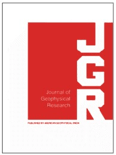
Journal of Geophysical Research-Biogeosciences
Advancing Our Understanding of Earth's Biogeochemical Interactions.Journal of Geophysical Research-Biogeosciences, published by the American Geophysical Union, is a premier academic journal dedicated to advancing our understanding of biogeochemical processes and their interactions within Earth's systems. With an impressive impact factor reflective of its rigorous peer-review process and outstanding scholarly contributions, the journal ranks in the Q1 quartile across a multitude of essential categories, including Aquatic Science, Atmospheric Science, Ecology, Forestry, Paleontology, Soil Science, and Water Science and Technology, highlighting its significance in multidisciplinary research. Researchers, professionals, and students alike will find invaluable insights and comprehensive studies that facilitate a deeper understanding of environmental changes and ecological dynamics. For those interested in open access options, it provides valuable networking among leading experts in the field, especially for collaborative research that aims to address critical global challenges related to climate change and ecosystem health. This journal serves as a key resource for anyone involved in geophysical and biogeosciences, making significant contributions toward the sustainability and management of Earth's biogeochemical cycles.
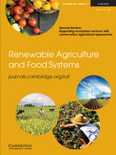
RENEWABLE AGRICULTURE AND FOOD SYSTEMS
Fostering collaboration for a greener agricultural landscape.RENEWABLE AGRICULTURE AND FOOD SYSTEMS, published by Cambridge University Press, is a leading open-access journal dedicated to the advancement of sustainability in agricultural practices and food systems. With an ISSN of 1742-1705 and an E-ISSN of 1742-1713, this journal spans the interdisciplinary fields of agronomy and food science, achieving a commendable Q2 ranking in both categories for 2023. As it continues to converge through the years from 2004 to 2024, the journal offers a platform for researchers, professionals, and students to disseminate transformative research that addresses the challenges of food security, resource management, and environmental impact. The journal’s significant impact is underscored by its Scopus rankings, situating it in the 77th percentile among agronomy and crop science publications, and the 67th percentile in food science. Since becoming fully open access in 2023, RENEWABLE AGRICULTURE AND FOOD SYSTEMS promotes wider accessibility to vital research findings, fostering collaboration and innovation in the pursuit of sustainable agricultural practices and food systems worldwide.

Lesnoy Zhurnal-Forestry Journal
Transforming Insights into Action for a Sustainable EnvironmentLesnoy Zhurnal-Forestry Journal is a prominent academic publication dedicated to advancing the field of forestry and environmental sciences. Published by the Northern Arctic Federal University M. V. Lomonosov, this journal focuses on innovative research, practices, and policies related to forestry management and conservation. With an Open Access model established since 2015, the journal ensures widespread dissemination of knowledge and foster collaborative research across global scholarly communities. Located in Arkhangelsk, Russia, the Lesnoy Zhurnal appeals to researchers, professionals, and students alike, providing a platform for sharing valuable insights and addressing emerging challenges in forestry. Though specific metrics like HIndex and Scopus rankings are presently unlisted, the journal is committed to excellence and aims to enhance its visibility and impact within the scientific community. This publication is not only a critical resource for ongoing research but a key player in shaping sustainable forestry practices in a rapidly changing environment, making it indispensable for anyone involved in forestry and environmental studies.
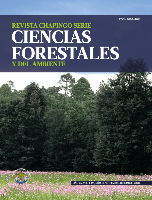
Revista Chapingo Serie Ciencias Forestales y del Ambiente
Advancing knowledge in Ecology and Forestry.Revista Chapingo Serie Ciencias Forestales y del Ambiente, published by Universidad Autónoma Chapingo, serves as a prominent platform for scholars and practitioners in the fields of Ecology and Forestry. Established in 2001, this open access journal has made significant strides in disseminating research that addresses pressing environmental issues, particularly within the Mexican context. With an ISSN of 2007-3828 and E-ISSN of 2007-4018, it has been recognized for its contributions, earning a Q3 ranking in both Ecology and Forestry categories as of 2023. The journal is pivotal in fostering collaboration and knowledge exchange among researchers, professionals, and students dedicated to understanding and preserving forest ecosystems. Access to its rich content is unrestricted, enhancing visibility and impact for innovative research and practical applications in sustainable management and conservation practices.
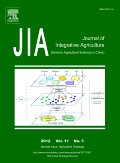
Journal of Integrative Agriculture
Transforming Agricultural Science with Integrative ApproachesJournal of Integrative Agriculture, published by Elsevier Science Ltd, stands as a leading platform for innovative research at the intersection of agricultural sciences. With a significant focus on integrative approaches, this journal has established itself within the academic community, reflecting its excellence through impressive Impact Factor rankings and a consistent Q1 category status in multiple fields, including Agronomy, Animal Science, and Ecology. The journal spans a wide range of topics, making it a critical resource for exploring advancements in Biochemistry, Food Science, and Plant Science. With its diverse Scopus rankings—from Rank #3 in Food Animals to Rank #14 in Animal Science—it serves as a vital repository for cutting-edge research that influences both scientific inquiry and practical applications in the agricultural domain. Operating from China and accessible through open access options, the Journal of Integrative Agriculture aims to foster collaborative research and knowledge exchange among scientists, professionals, and students worldwide, supporting the growth and sustainability of agricultural practices.

Icelandic Agricultural Sciences
Nurturing Sustainable Practices in AgronomyIcelandic Agricultural Sciences, published by RANNSOKNASTOFNUN LANDBUNADARINS, serves as a vital platform for the dissemination of research in the field of Agronomy and Crop Science. Established to contribute to the advancement of agricultural knowledge in Iceland and beyond, this journal aims to foster collaboration among researchers, professionals, and students dedicated to sustainable agricultural practices. Despite facing a Q4 category ranking in 2023 and a ranking of #344/406 in Scopus, the journal continues to attract diverse research contributions, especially focusing on unique challenges and innovations pertinent to Icelandic agriculture. The journal operates under a traditional access model, providing an essential resource for those looking to deepen their understanding of agronomic developments and their implications for the agricultural sector. With a commitment to increasing awareness and promoting scientific dialogues, Icelandic Agricultural Sciences plays a crucial role in nurturing the field's growth and enhancing agricultural research.